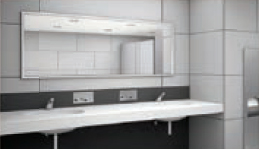


Authentic Sustainability in the Restroom
Authentic Sustainability in the Restroom Designing for Authentic Sustainability When architects are tasked with envisioning a brand new, potentially LEED®-certified building, it should be designed with sustainability in mind every step of the way. Not only is it...
The Free Vend Trend
Between changes in patron preferences and new legislation, free feminine products are increasingly seen as a necessity.

A Helping Hand for Dryer Selection
Choosing the right hand dryer can facilitate a range of benefits for facilities. It can be the finishing touch that ties together a restroom’s high-end aesthetic, align with a facility’s goal of being ADA-complaint and help create a healthy, hygienic environment. A great hand dryer choice can also facilitate significant long-term cost savings for the owner while reducing the impact of the restroom on the environment.

Solutions For A Multigenerational Market
Recent demographic and social trends have increased demand for multigenerational design in the commercial building environment, and the restroom offers many opportunities for designers to cater to a full spectrum of generational challenges.

